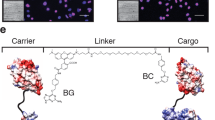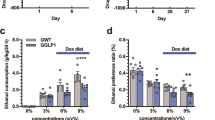Abstract
We developed a gene gun method for the transfer of human agouti signalling protein (ASP) cDNA to alter rat skin colour in vivo. Human ASP cDNA was cloned into a modified cytomegalovirus plasmid and delivered to the skin of Long–Evans rats by gene gun bombardment. Skin pigmentation, body weight and blood sugar of ASP cDNA-transfected rats were recorded against the control group, which were injected with plasmids encoding for green fluorescent protein. The treated skin showed lighter skin colour after 3 days of ASP gene transfection. This depigmentation effect was most prominent on day 14 and the skin gradually returned to its original pigmentation by day 28. Successful transfection of ASP gene in skin and hair follicles, as well as downregulation of melanocortin-1 receptor (MC1R) and tyrosinase expression upon treatment, was confirmed using immunohistochemistry and Western blot analysis. Body weight and blood sugar in the treated rats did not show statistically significant differences as compared to control groups. These observations demonstrate that gene transfer using the gene gun method can induce high cutaneous ASP production and facilitate a switch from dark to fair colour without systemic pleiotropic effects. Such a colour switch may be that ASP is acting in a paracrine fashion. In addition, this study verifies that ASP exerts its functions by acting as an independent ligand that downregulates the melanocyte MC1R and tyrosinase protein in an in vivo system. Our result offers new, interesting insights about the effect of ASP on pigmentation, providing a novel approach to study the molecular mechanisms underlying skin melanogenesis.
This is a preview of subscription content, access via your institution
Access options
Subscribe to this journal
Receive 12 print issues and online access
$259.00 per year
only $21.58 per issue
Buy this article
- Purchase on Springer Link
- Instant access to full article PDF
Prices may be subject to local taxes which are calculated during checkout





Similar content being viewed by others
References
Barsh GS . The genetics of pigmentation: from fancy genes to complex traits. Trends Genet 1996; 12: 299–305.
Lu D et al. Agouti protein is an antagonist of the melanocyte-stimulating-hormone receptor. Nature 1994; 371: 799–802.
Siegrist W, Willard DH, Wilkison WO, Eberle AN . Agouti protein inhibits growth of B16 melanoma cells in vitro by acting through melanocortin receptors. Biochem Biophys Res Commun 1996; 218: 171–175.
Abdel-Malek ZA et al. The melanocortin 1 receptor is the principal mediator of the effects of agouti signaling protein on mammalian melanocytes. J Cell Sci 2001; 114: 1019–1024.
Bultman SJ, Michaud EJ, Woychik RP . Molecular characterization of the mouse agouti locus. Cell 1992; 71: 1195–1204.
Barsh GS et al. Molecular pharmacology of Agouti protein in vitro and in vivo. Ann NY Acad Sci 1999; 885: 143–152.
Millar SE, Miller MW, Stevens ME, Barsh GS . Expression and transgenic studies of the mouse agouti gene provide insight into the mechanisms by which mammalian coat color patterns are generated. Development 1995; 121: 3223–3232.
Ollmann MM et al. Antagonism of central melanocortin receptors in vitro and in vivo by agouti-related protein. Science 1997; 278: 135–138.
Suzuki I et al. Agouti signaling protein inhibits melanogenesis and the response of human melanocytes to alpha-melanotropin. J Invest Dermatol 1997; 108: 838–842.
Kucera GT, Bortner DM, Rosenberg MP . Overexpression of an agouti cDNA in the skin of transgenic mice recapitulates dominant coat color phenotypes of spontaneous mutants. Dev Biol 1996; 173: 162–173.
Teichler Zallen D . US gene therapy in crisis. Trends Genet 2000; 16: 272–275.
Greenhalgh DA, Rothnagel JA, Roop DR . Epidermis: an attractive target tissue for gene therapy. J Invest Dermatol 1994; 103: 63S–69S.
Chen CH et al. Gene gun-mediated DNA vaccination induces antitumor immunity against human papillomavirus type 16 E7-expressing murine tumor metastases in the liver and lungs. Gene Therapy 1999; 6: 1972–1981.
Lu CY et al. Gene-gun particle with pro-opiomelanocortin cDNA produces analgesia against formalin-induced pain in rats. Gene Therapy 2002; 9: 1008–1014.
Yang NS, Sun WH . Gene gun and other non-viral approaches for cancer gene therapy. Nat Med 1995; 1: 481–483.
Abdel-Malek Z et al. The melanocortin-1 receptor is a key regulator of human cutaneous pigmentation. Pigment Cell Res 2000; 13 (Suppl 8): 156–162.
Miller MW et al. Cloning of the mouse agouti gene predicts a secreted protein ubiquitously expressed in mice carrying the lethal yellow mutation. Genes Dev 1993; 7: 454–467.
Scott MC, Suzuki I, Abdel-Malek ZA . Regulation of the human melanocortin 1 receptor expression in epidermal melanocytes by paracrine and endocrine factors and by ultraviolet radiation. Pigment Cell Res 2002; 15: 433–439.
Adachi S et al. Involvement of mi-transcription factor in expression of alpha-melanocyte-stimulating hormone receptor in cultured mast cells of mice. J Immunol 2000; 164: 855–860.
Aberdam E et al. Involvement of microphthalmia in the inhibition of melanocyte lineage differentiation and of melanogenesis by agouti signal protein. J Biol Chem 1998; 273: 19560–19565.
Wang X, Zinkel S, Polonsky K, Fuchs E . Transgenic studies with a keratin promoter-driven growth hormone transgene: prospects for gene therapy. Proc Natl Acad Sci USA 1997; 94: 219–226.
Lin MT, Wang F, Uitto J, Yoon K . Differential expression of tissue-specific promoters by gene gun. Br J Dermatol 2001; 144: 34–39.
Halprin KM . Epidermal ‘turnover time’ – a re-examination. Br J Dermatol 1972; 86: 14–19.
Klebig ML, Wilkinson JE, Geisler JG, Woychik RP . Ectopic expression of the agouti gene in transgenic mice causes obesity, features of type II diabetes, and yellow fur. Proc Natl Acad Sci USA 1995; 92: 4728–4732.
Lin MT, Pulkkinen L, Uitto J, Yoon K . The gene gun: current applications in cutaneous gene therapy. Int J Dermatol 2000; 39: 161–170.
Acknowledgements
This work was performed with the support of the Industrial Technology Research Institute of Taiwan and the National Science Council Grant NMRP 92-2314-B-182A-202 and Genome Project. We thank Dr VJ Hearing (National Cancer Institute, National Institutes of Health, MD, USA) for the polyclonal antibody (aPEP16) and Dr GS Barsh (Department of Pediatrics and Genetics, Stanford University School of Medicine, CA, USA) for the ASP plasmid.
Author information
Authors and Affiliations
Rights and permissions
About this article
Cite this article
Yang, CH., Shen, SC., Lee, J. et al. Seeing the gene therapy: application of gene gun technique to transfect and decolour pigmented rat skin with human agouti signalling protein cDNA. Gene Ther 11, 1033–1039 (2004). https://doi.org/10.1038/sj.gt.3302264
Received:
Accepted:
Published:
Issue Date:
DOI: https://doi.org/10.1038/sj.gt.3302264
Keywords
This article is cited by
-
The use of polyethylenimine–DNA to topically deliver hTERT to promote hair growth
Gene Therapy (2012)
-
Visualization of plasmid delivery to keratinocytes in mouse and human epidermis
Scientific Reports (2011)
-
Increased interstitial pressure improves nucleic acid delivery to skin enabling a comparative analysis of constitutive promoters
Gene Therapy (2010)
-
Hair follicle stem cell-targeted gene transfer and reconstitution system
Gene Therapy (2006)
-
Biolistic transfection of neuronal cultures using a hand-held gene gun
Nature Protocols (2006)



